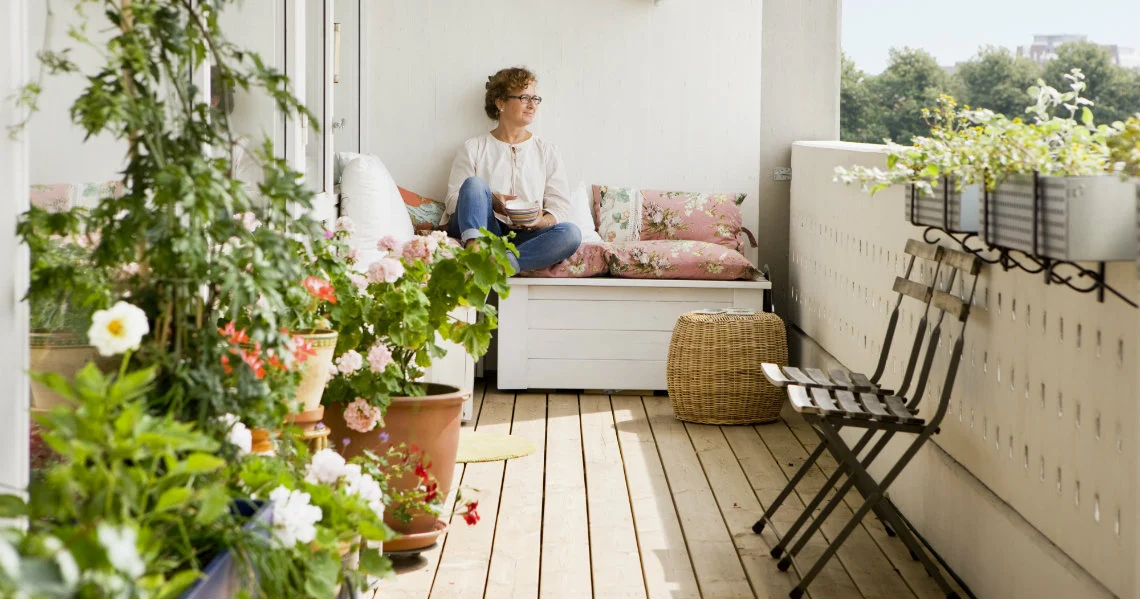Many gardeners in Malta do not have the luxury of a plot of land for a garden and are confined to growing plants on a balcony or a roof terrace. There are a lot of plants which will grow successfully in pots, mostly the sub-tropicals like Hibiscus and Passion Flower. Additionally, some true mediterranean plants can survive quite happily and many of the native bulbs can be enjoyed each spring if kept in pots.

Choosing the Pots
Terracotta or plastic pots? Clay pots look nicer and ‘breathe’, but plastic pots are much lighter when weight is a consideration on balconies and roof terraces. Terracotta pots, being porous, lose moisture by evaporation from their sides. This makes the soil within them less likely to become dank and stagnant. Plants in plastic pots will need slightly less water than those in clay pots and care must be taken not to over-water them.
To help achieve good drainage, it is usual to place bits of broken flower-pot or pebbles at the bottom of the pot before adding soil and planting. Good drainage may also be assured by raising the pots stones, pot feet, or by using plant stands.
If you have saucers under your pots, remove them in autumn/winter so that the plant doesn’t sit around in water after rain.
Always choose the size of the pot to fit the plant, in other words don’t put small plants in large pots. The reason for this is that as the plant’s roots take up water, oxygen is drawn into the soil. If the pot is too big, there is a large volume of soil from which water is not taken by the roots. This will cause deprivation of oxygen and stagnation, or even waterlogging, causing the plant to do badly or die.
Special Offer on Balcony Pots

Buy any 3 Capri Balcony Pots and Capri Balcony Plant Boxes and get the 4th for free! Offer is available exclusively at our shop in Burmarrad.
Watring your Plants
How much water your pots will need and how often they will need watering depends on various factors. Such as the type and size of plant, their exposure (full sun, partial shade, shade) and the weather conditions.
It’s important to keep in mind that more plants die from over-watering than from under-watering.
If you install drip irrigation, choose the output from each dripper according to the plant’s needs (e.g. geraniums need smaller quantities, annual climbers need more, etc).
On the other hand, watering by hand has the advantage that you can assess each plant’s needs individually, day by day.
Whether by drip irrigation or by hand, always water early in the morning or in the evening, after the sunlight has passed over your plants.
Avoid spraying the foliage with water in summer mornings as this tends to cause galls on stems and branches.
-

Aquauno Select Water Timer
Irrigation programming has never been easier. With only 2 Dial Settings, Aquauno...
€63.50 -

Hozelock Superhoze 7.5M
Expands up to x3 its original length and quickly shrinks back to its original si...
€33.00 -
Sale!

Mondego Watering Can 10l Dry Green
W 54cm x H 34.5cm x D 18.7cm - 10L
Original price was: €11.20.€9.90Current price is: €9.90. -

SOGO Instant drip watering system Hose 6m
Micro Irrigation system set
€13.95
Trouble Choosing a Plant?
Some shrubs that do well in pots in sunny positions include; Oleanders, Lantanas, Geraniums, Hibiscus, and Callistemon. In shade you can grow various ferns and fuchsias. In semi-shade try Jasminum sambac and plumbago.
Where space is limited on a terrace, climbers are a great solution. These can be grown on wires or trellises. Solanum jasminoides, Pandorea jasminoides, Bougainvilleas, and Passion flowers are all good options.
When it comes to kitchen herbs mint, chives, parsley and chilli are great options. Many typically Mediterranean plants such as lavender are not well suited to cultivation in pots. In their natural habitat they develop deep woody roots in order to survive the summer drought and do not need or want water. The restriction of a pot prevents the plant from making its deep roots. No plant in a pot can survive the summer unwatered, so for those plants that don’t want water it is hard to find the right balance.
Having said that, it is always worth experimenting with any plant that you’d really like to grow.